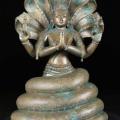30. Philipp Maas on Yoga
A leading expert on the founding text of Yoga tells us why, when, and by whom it was written, and what it has to do with modern day yoga practice.
Themes:
• P. Maas, Samādhipāda: the First Chapter of the Pātanjalayogaśāstra for the First Time Critically Edited (Aachen: 2006).
• P. Maas, “The Concepts of the Human Body and Disease in Classical Yoga and Ayurveda,” Wiener Zeitschrift für die Kunde Südasiens 51 (2007/2008), 125-62.
• P. Maas, “‘Descent with Modification’: The Opening of the Pātanjalayogaśāstra,” in W. Slaje (ed.), Śāstrārambha: Inquiries into the Preamble in Sanskrit (Wiesbaden: 2008), 97-119.
• P. Maas, “The So-called Yoga of Suppression in the Pātanjala Yogaśāstra,” in E. Franco (ed.), Yogic Perception, Meditation, and Altered States of Consciousness (Vienna: 2009), 263-82.
• P. Maas, “Valid Knowledge and Belief in Classical Sāmkhya Yoga,” in P. Balcerowicz (ed.), Logic and Belief in Indian Philosophy (Delhi: 2010), 383-92.
• P. Maas, “A Concise Historiography of Classical Yoga Philosophy,” in E. Franco (ed.), Periodization and Historiography of Indian Philosophy (Vienna: 2013), 53-90.







Comments
outstanding
This was a brilliant exposition! May everyone experience Yoga!
Add new comment